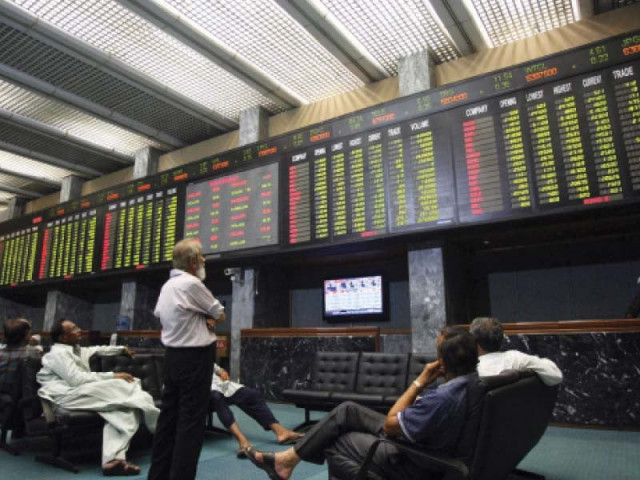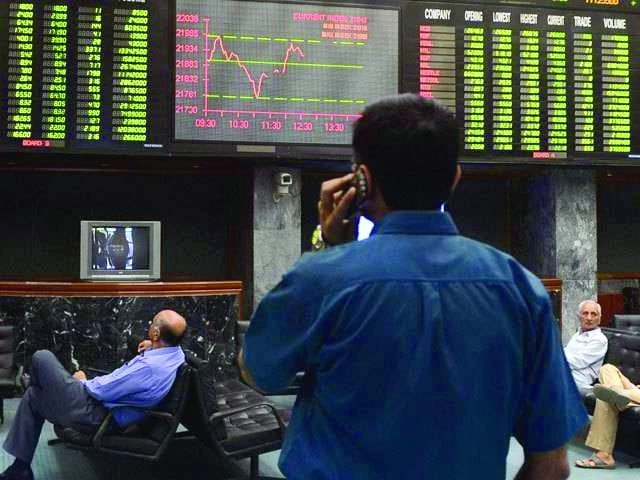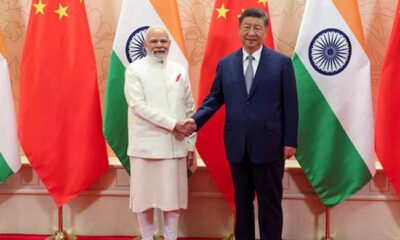Business
Pakistan’s stock market needs depth, not drama | The Express Tribune

With most gains driven by financials and energy giants, PSX lacks broad participation needed for durable bull run
KARACHI:
Pakistan’s stock market has been a study in contrasts this year: pockets of bullish enthusiasm punctuated by sharp swings that leave investors – and policymakers – uneasy. The benchmark KSE-100 index, which began 2025 on a recovery path after a turbulent 2024, has repeatedly tested new highs and then surrendered large chunks of gains within days, illustrating how sensitive the Pakistan Stock Exchange (PSX) has become to domestic policy cues, regional geopolitics, and global risk sentiment.
On October 24, 2025, the index traded around the mid-160,000s intraday, showing ranges that investors described as “wide” and “whippy” rather than steady appreciation. Volatility has not been purely technical; it has often been triggered by identifiable events.
In April 2025, trading was halted for 45 minutes after the KSE-100 plunged more than 5% in a single session as global risk aversion spiked and regional uncertainty rose – an episode that underscored how quickly sentiment can reverse even when fundamentals appear to be stabilising.
The market’s dependence on foreign portfolio flows, and its limited depth compared with larger emerging markets, means that short, concentrated flows can move prices dramatically.
Domestic macro policy has been another major driver of market moves. The State Bank of Pakistan (SBP)’s easing cycle through the first half of 2025, including rate cuts totalling several hundred basis points compared with 2024 peaks, supported a recovery in interest-sensitive sectors and encouraged risk appetite among local institutional investors.
But monetary easing also raised questions about inflation and currency stability, which, in turn, prompted profit-taking when headlines suggested rising external pressures or potential reversals in policy. That tug-of-war between easing for growth and guarding against macro risks has been priced into PSX volatility.
The market’s advances have been concentrated. Financials, selected energy names, and large exporters accounted for a disproportionate share of gains during rallies, while small-cap and mid-cap segments frequently lagged or underperformed during corrections. This concentration increases systemic volatility because heavy exposure to a few big names magnifies the effect of any negative news tied to those companies or sectors.
Even on days when the headline index gains, breadth often remains narrow – another red flag for investors seeking durable rallies. PSX market summaries and turnover statistics show recurrent patterns of heavy volume on a limited number of symbols.
Foreign investor behaviour has been decisive at turning points. Inflows associated with short-term hedge funds or opportunistic foreign portfolio investors have magnified rallies, but sudden stops or reversals – prompted by global events such as changes in US interest rate expectations or geopolitical flare-ups – have intensified declines.
Local institutional participation has grown but still struggles to fully offset the volatility imparted by cross-border capital. The exchange’s 2025 annual report and market data highlight both increasing market capitalisation and the still-fragile composition of flows.
Liquidity dynamics add another layer to the story. While market capitalisation has expanded in the past year, turnover ratios and average daily traded value show episodes of thin liquidity, especially outside the top 20 stocks.
Thin trading amplifies price moves: modest sell orders can cascade if buyers are scarce. Recent intraday ranges – sometimes exceeding several thousand index points – reflect that liquidity mismatch. For risk managers and retail investors, that means stop-losses and margin calls can be triggered more easily now than in a deep, liquid market.
Geopolitical shocks have repeatedly convulsed the PSX. In months when regional tensions flared, the index suffered steep sell-offs and occasionally triggered cooling mechanisms or temporary halts; conversely, diplomatic breakthroughs or easing of tensions sparked quick recoveries and short squeezes.
The market’s sensitivity to such events is understandable – exporters, commodity prices, and investor confidence all react to geopolitical shifts – and it has made calendar risk a permanent feature of the PSX investment playbook.
Macro data and external account developments feed into market psychology as well. Pakistan’s trade deficits, remittance trends, and foreign exchange reserves are monitored closely by investors, and any sign of deteriorating external buffers tends to coincide with domestic equity sell-offs.
While policy actions – tariff adjustments, fiscal consolidation measures, or SBP interventions – may eventually stabilise macro variables, the market often reacts to the perceived probability and timing of those measures long before their economic impact is visible. Official monthly KSE indicators compiled by the SBP and PSX show how closely market moves track macro announcements.
Investor composition has evolved. Retail participation has risen alongside digital access to trading, while institutional investors – including pension funds and mutual funds – have steadily increased their presence. This democratisation brings both benefits – a broader investor base and deeper domestic pools of capital – and risks, as less-experienced retail investors can exacerbate momentum trading during both rallies and panics.
Education, stricter disclosure standards, and improved investor protection are therefore essential complements to any structural reform aimed at calming volatility.
Regulatory responses so far have been pragmatic but reactive. The PSX and the Securities and Exchange Commission of Pakistan (SECP) have used circuit breakers, trading halts, and disclosure requirements to limit disorderly moves, but long-term solutions require deeper structural changes.
These include broadening the investor base through institutional development, improving corporate governance, enhancing market infrastructure to reduce settlement and operational risk, and encouraging product innovation – such as derivatives and options – that allow for hedging of market and currency risk.
PSX’s 2025 initiatives around new index products and market data aim in that direction, but their stabilising impact will accrue only over time.
Volatility on the PSX is likely to persist – at least in the near term – because the market sits at the intersection of domestic policy shifts, lingering external vulnerabilities, and an increasingly connected global capital market where sentiment moves fast. That does not mean the PSX cannot offer attractive returns. Rather, it implies that returns will be accompanied by higher realised volatility, and that success will depend on both macro stability and deepening of market structures.
Policymakers, regulators, and market participants all have a role to play: improving transparency, nurturing local institutional capacity, and upgrading infrastructure will be the difference between a market that remains chronically volatile and one that evolves into a resilient and investor-friendly marketplace.
THE WRITER IS A MEMBER OF PEC AND HOLDS A MASTER’S DEGREE IN ENGINEERING
Business
Insolvency ruling: CoC cannot alter approved resolution plan or reallocate dissenting creditors’ funds, says NCLAT – The Times of India

The insolvency appellate tribunal NCLAT has ruled that the Committee of Creditors (CoC) cannot modify an approved resolution plan to reallocate funds meant for dissenting financial creditors, reaffirming limits on the exercise of commercial wisdom after a plan has been cleared, PTI reported.Dismissing an appeal filed by Bank of Baroda in the insolvency proceedings of Reliance Communications Infrastructure Ltd (RCIL), a two-member bench of the National Company Law Appellate Tribunal said that once a resolution plan is approved, the assenting members of the CoC cannot alter its financial distribution framework.“It is true that the CoC with commercial wisdom can take a decision regarding different aspects of the plan, including manner of distribution, but once the commercial wisdom has been exercised by approving the resolution plan in meeting, the modification of the said distribution mechanism, which is impermissible, cannot be saved in the name of commercial wisdom of the CoC,” NCLAT said in its order.The appeal arose from the insolvency resolution of RCIL, where the National Company Law Tribunal (NCLT) had approved the resolution plan submitted by Reliance Projects & Property Management Services Ltd (RPPMSL), a subsidiary of Jio. The plan was approved by 67.97 per cent of the CoC by vote share on August 5, 2021.While Bank of Baroda voted in favour of the plan, lenders including IDBI Bank and State Bank of India dissented. The plan was subsequently placed before the Mumbai bench of the NCLT for approval.Bank of Baroda later approached the NCLT seeking directions to convene a CoC meeting to consider reallocation of proceeds under the approved resolution plan, particularly in relation to a loan to Reliance Bhutan. Acting on this, the NCLT on October 17, 2023 directed the resolution professional to convene a CoC meeting.At the meeting held on October 27, 2023, a resolution proposing reallocation and reassignment of the Reliance Bhutan loan was passed with a 67.55 per cent majority, though IDBI Bank and SBI objected to the move.On December 19, the NCLT approved the resolution plan as originally proposed by RPPMSL. IDBI Bank subsequently challenged the October 27, 2023 CoC decision, arguing that the reallocation of proceeds violated the approved resolution plan.The NCLT held that the CoC could not alter the financial layout relating to the entitlement of financial creditors once the resolution plan had been approved. It also noted that the Reliance Bhutan loan, which was to be assigned to assenting financial creditors under the plan, could not be reassigned to dissenting lenders through a subsequent CoC decision.In its October 10, 2025 order, the NCLT ruled that the approved resolution plan could not be modified in this manner. Bank of Baroda challenged this decision before the NCLAT.Upholding the NCLT’s view, the appellate tribunal said, “The Adjudicating Authority in the impugned order after considering all relevant clauses has rightly come to the conclusion that the decision of the CoC dated 27.10.2023 is contrary to the approved resolution plan and cannot bind the dissenting financial creditors.”“We are in full agreement with the view taken by the adjudicating authority as noted above. The adjudicating authority did not commit any error in allowing the plea filed by the IDBI Bank. We do not find any good ground to interfere with the decision of the adjudicating authority,” NCLAT added, dismissing the appeal.
Business
Apollo Techno Industries IPO Last Day: Issue Receives 50.63x Subscription; GMP Rises To 9.23%

Last Updated:
Unlisted shares of Apollo Techno Industries are trading at Rs 136 apiece in the grey market, which is 4.6% premium over the issue price of Rs 130, indicating weak listing.
Apollo Techno Industries IPO.
Apollo Techno Industries IPO GMP: The initial public offering (IPO) of Apollo Techno Industries Ltd (ATIL) has been closed today, Friday, December 26. The price band of the Rs 47.96-crore IPO has been fixed in the range of Rs 123 and Rs 130. On the final day of bidding on Friday, the IPO received a total of 50.63x times subscription, garnering bids for 12,42,53,000 shares as against 24,54,000 shares on offer.
Its retail category got a 44.81x subscription, while its non-institutional investor (NII) quota got a 98x subscription. Its qualified institutional buyer (QIB) category has received a 25.26x subscription.
ATIL is a manufacturer specialising in trenchless technology and foundation equipment for the construction industry
Apollo Techno Industries IPO GMP Today
According to market observers, unlisted shares of Apollo Techno Industries Ltd are currently trading at Rs 142 apiece in the grey market, which is a 9.23 per cent premium over the issue price of Rs 130. It indicates a weak listing. Its listing will take place on December 31, Wednesday.
The GMP had stood at 4.62 per cent in the morning.
The GMP is based on market sentiments and keeps changing. ‘Grey market premium’ indicates investors’ readiness to pay more than the issue price.
Apollo Techno Industries IPO: More Details
The Apollo Techno Industries Limited IPO is a book-built issue worth ₹47.96 crore, comprising only a fresh issue of 0.37 crore equity shares. There is no offer-for-sale component in the issue.
The IPO opened for subscription on December 23, 2025, and will close on December 26, 2025. The basis of allotment is expected to be finalised on December 29, 2025, while the shares are scheduled to list on the BSE SME platform on December 31, 2025, subject to approvals.
The price band for the issue has been fixed at Rs 123 to Rs 130 per share. The lot size is 1,000 shares. Retail investors are required to apply for a minimum of 2 lots (2,000 shares), translating into an investment of Rs 2.60 lakh at the upper end of the price band. For HNIs, the minimum application size is 3 lots (3,000 shares), amounting to Rs 3.90 lakh.
Beeline Capital Advisors Pvt Ltd is the book running lead manager to the issue, while MUFG Intime India Pvt Ltd is acting as the registrar. The market-making duties will be handled by Spread X Securities Pvt Ltd.
Apollo Techno Industries reported strong financial growth in FY25. The company’s revenue rose 44 percent, while profit after tax (PAT) surged 327 percent for the year ended March 31, 2025, compared with the previous financial year.
Incorporated in 2016, Apollo Techno Industries operates in the manufacturing and technology space, with a focus on equipment used in the construction and infrastructure sector.
The company specialises in trenchless technology and foundation equipment, catering to complex construction requirements. Its product portfolio includes Horizontal Directional Drilling (HDD) rigs, Diaphragm Drilling Rigs, Rotary Drilling Rigs, along with associated spare parts.
December 26, 2025, 10:51 IST
Read More
Business
PIA privatisation drives PSX gains | The Express Tribune

The KSE-100 Index posted a solid +0.58% gain on a week-on-week basis, closing the period on a positive note amid strong investor sentiment.
The primary catalyst was the landmark privatization of Pakistan International Airlines (PIA), finalized at Rs135 billion (approximately US$480 million), marking one of the largest and most significant privatization deals in Pakistan's history.
The successful auction, won by the Arif Habib-led consortium for a 75% stake, signals a major step toward reducing the government's burden from loss-making state-owned enterprises and boosting private sector confidence.
Market Snapshot – December 26th, 2025
Unlock today’s market moves and stay one step ahead!
Here’s what’s making waves:
ETFs (Exchange Traded Funds): Most Active in Today’s Market
Market Indices – At a Glance:
•KSE-100: Pullers & Draggers
•KMI-30: Pullers & Draggers pic.twitter.com/rCQIk0IVGt
— PSX (@pakstockexgltd) December 26, 2025
A positive session was observed at the exchange, as the index gained to close at an all-time high of 172,400 level (up by +0.92%).
Top positive contributions to the index came from ENGROH, PPL, SYS, NBP, and MLCF, as they cumulatively added +774 points to the index, according to Topline Securities. Traded value-wise, BOP (Rs3.1b), NBP (Rs2.94b), SEARL (Rs2.05b), PPL (Rs2.03b), PTC (Rs1.51b), and MLCF (Rs1.35b) dominated the trading activity. Traded value and volume for the day stood at 797 million shares and Rs38b, respectively.
Today, 59% of the total equity value traded at PSX was in Shariah-compliant stocks!
Learn about the top 3 Shariah Compliant Stocks in today's PSX Market Breakdown pic.twitter.com/TXQAxCc95U
— PSX (@pakstockexgltd) December 26, 2025
This positive momentum was further supported by the State Bank of Pakistan's (SBP) recent 50 basis points policy rate cut to 10.5%, which continued to encourage investment in equities by lowering borrowing costs and improving liquidity. Trading activity remained robust, with average daily volumes at 736 million shares and a value of Rs31.5b.
Analysts view this as a turning point for market reforms, with the PIA deal expected to pave the way for more divestments and enhanced economic efficiency.
Source link
-

 Fashion1 week ago
Fashion1 week agoIndonesia’s thrift surge fuels waste and textile industry woes
-

 Business1 week ago
Business1 week agoBP names new boss as current CEO leaves after less than two years
-

 Tech1 week ago
Tech1 week agoT-Mobile Business Internet and Phone Deals
-

 Sports1 week ago
Sports1 week agoPKF summons meeting after Pakistani player represents India in kabaddi tournament
-

 Entertainment1 week ago
Entertainment1 week agoIndia streamlines visa rules in boost for Chinese professionals
-

 Sports1 week ago
Sports1 week agoUWCL grades for all 18 teams: Leuven get A+; Barça an A-, PSG fail
-
Sports6 days ago
Alabama turned Oklahoma’s College Football Playoff dream into a nightmare
-

 Entertainment1 week ago
Entertainment1 week agoRadiation fears rise after cracks found in $2 billion Chernobyl shield










